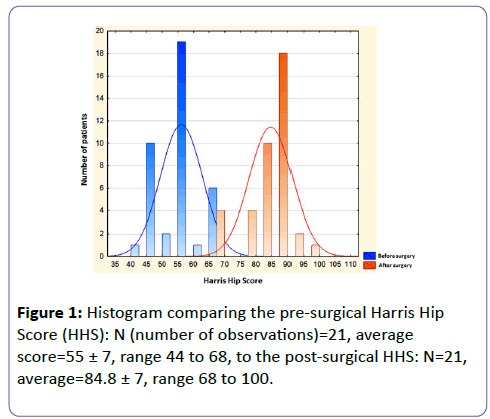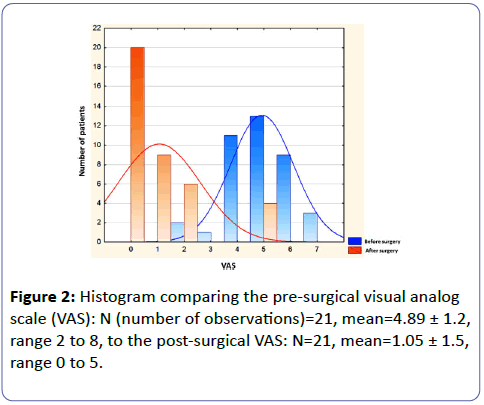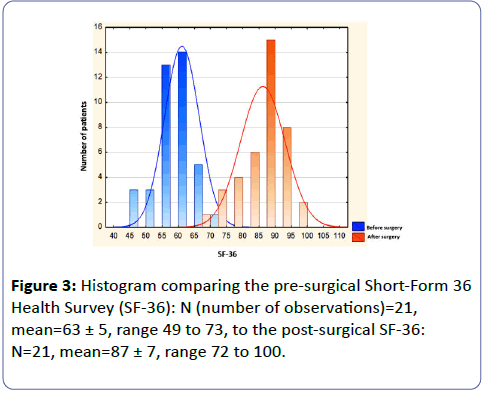Paweł Skowronek, Artur Wojciechowski, Arkadiusz Madej, Jacek Mazek, Agnieszka Maksymiuk-Kłos* and Paweł Piątkiewicz
Mazowiecki Szpital Brodnowski w Warszawie Sp zoo Warsaw, Poland
- *Corresponding Author:
- Agnieszka Maksymiuk-Kłos
Mazowiecki Szpital Brodnowski w Warszawie Sp zoo, Poland
Tel: +48 508183019
E-mail: agamaksymiuk@gmail.com
Received date: November 12, 2017; Accepted date: November 20, 2017; Published date: November 27, 2017
Citation: Skowronek P, Wojciechowski A, Madej A, Mazek J, Agnieszka Maksymiuk-Kłos, et al. (2017) Treatment Outcome of Hip Arthrosis by a Mini-Open Direct Anterior Approach (DAA) in Patients with American Society of Anaestesiology Scale III (ASA III). J Clin Exp Orthop Vol.3:46. doi: 10.4172/2471-8416.100046
Copyright: © 2017 Skowronek P, et al. This is an open-access article distributed under the terms of the Creative Commons Attribution License, which permits unrestricted use, distribution, and reproduction in any medium, provided the original author and source are credited.
Keywords
Anaestesiology; Hip arthrosis; Direct anterior approach; Joint disease
Introduction
Ostheoarthrosis (OA) and femoro-acetabular conflict (FAI) is a common cause of hip pain and considered as being a precursor to full pain in osteoarthritis [1-4]. Damage to the acetabular labrum, cartilage, the presence of pain and decreasing of range of motion (ROM) are the most frequent indications for surgical intervention [5]. There is no consensus as to the optimal surgical treatment for middle OA and FAI. Arthroscopy of the hip joint is one of the methods of treatment; however, it is a technically demanding procedure and requires a long-term arthroscopy experience and learning curve (LC). Total hip replacement is recommended by WHO, but more risky with cardiac patients. In particular the risk of DVT, fat embolism, cardiological abnormalities in the course of the procedure and the consequences of interference in the pelvic girdle and the femoral cavity of the femur, significantly increases [1,2]. Frederic C, et al. study, the use of beta-blockers was connected with an increased risk of cardiac complications [2]. Long-term traction and relatively long surgery time are additional disadvantages of the arthroscopy [6-9]. Different surgical procedures, such as the Ganz procedure with osteotomy of the greater trochanter and dislocation of the femoral head, can be performed as well [10], but an extensive approach and the need for dislocation represent excessive surgical intervention and higher risk of cardiac complication during long surgery. This procedure offer the advantages of visibility, access around the femoral head and a clear view of the acetabular labrum [11-14], but it bears the potential complication of iatrogenic avascular necrosis of the femoral head. Surgery with increasing of ROM, decreasing of pain can be done with the resection of osteophytes on the femoral head by a mini invasive direct anterior approach (DAA) [7].
We hypothesized that the mini-open DAA might combine the advantages of the arthroscopic and open surgical dislocation approaches for the treatment of OA and FAI with less of cardiac complications. This study was designed to describe the surgical technique and determine the clinical outcomes of the MIS DAA in young patients with ASA III treated in our institution. We also compare the surgical outcomes with those reported for other approaches for surgically treating of early OA and FAI.
Patients and Methods
Patients and study entry criteria
The local institutional review board approved this retrospective review of 21 patients with ASA III treated for middle AO and FAI in our institution between March 2010 and September 2013. Informed consent was waived. Several categories of cardiovascular risk factors were evaluated: medical history (hypertension, arrhythmia, MI, CHF, hyperlipidemia) physical examination, EKG. All patients were diagnosed as having secondary hip pain and decreasing range of motion (ROM). The study group comprised 17 males and 4 females, with an average age of 51.4 (range 43 to 55) years. The diagnosis of OA and FAI was made on the clinical examination and radiographic evaluation–two projections AP and axis. The impingement test, i.e., pain in flexion, adduction and internal rotation, was positive in all patients. An additional magnetic resonance imaging study was performed in seven patients in order to diagnose labrum tears and cartilage. Patients that had prior hip surgery were excluded. The mean follow-up was 35 (range 21 to 51) months.
Surgical procedure
The same hip surgeon (PS) performed all of the procedures in the same fashion with the patient under spinal anaesthesia and in the supine/horizontal position. A standard mini-open DAA was done, employing incisions of the skin medial to the tensor fasciae latae muscle (TFL). A proximal starting point of incision was made 3-4 fingers from the superior iliac anterior spine (SIAS) along the line between the SIAS and the top of the greater trochanter. A 6 to 8 cm slightly curved cut was then made towards the fibular head as an original DAA technique. The articular capsule was found in the intermuscular space between the tensor fasciae latae and the sartorius muscles. Two or three retractors were used to expose the joint capsule. A T-shaped cut of the capsule was made and the labrum and base of femoral head were exposed. High-speed burrs were used to resect and remove the osteophytes from the anterior and superior aspects of the acetabulum and femoral head. In 8 cases the labrum was reinserted to the bone by bone anchors. The ROM of the joint and the stability of the labrum were checked, after which the joint capsule was closed. The procedure was finish by fascial, subcutaneous and skin stitches. A drain was left for 24 h. Post op X-ray images were taken to evaluate the degree of osteophyte resection.
All the patients had an ostheophytes in femoral head, which was excised with a burr or chisel. Labrum tears were found in 8 out of 21 patients, and refixation was by two or three bone anchors in 2 cases, partial excision in 3 cases, complete excision in 3 cases, and left intact in the remaining case.
The patients were allowed to walk next day with the using of two crutches on the first postoperative day. Flexion of the hip was restricted to 90°, with fully restricted internal and external rotation, for the first two postoperative weeks. Exercises on a stationary bike were recommended as standard procedure during the week following the operation. After the removal of the stitches after 2-3 weeks, the range of flexion increased to 110. The patients were discharged on the third day. Standard follow-up visits took place 4, 8 and 12 weeks after surgery.
Outcome measures
The ROM of the hip joint was examined in all patients before the surgery and during follow-up visits. Primary osteoarthritis (OA) was assessed according to the Tönnis score [15]. The functional outcomes were assessed with the Harris Hip Score (HHS) [16] and Short-Form 36 Health Survey (SF-36) [17]. Pains were assessed by a standard 10-point visual analog scale (VAS) score.
Statistical analysis
In study was used Shapiro-Wilk test to the distributions of the HHS, VAS and SF-36 scores for normality. The Student’s t-test was used only to compare preoperative and postoperative statuses for normally distributed variables. Additional Mann- Whitney U-test was used to compare non-normally distributed variables. Statistical analysis was carried out by the SPSS for Windows software, version 22.0 (Chicago, IL), and significance was set at p ≤ 0.05.
Results
At the final follow-up, the mean HHS score was 29.3 points higher than baseline (specifically, 55.4 ± 12 before surgery versus 84.8 ± 16 points at last follow-up, p<0.00001) (Figure 1). The mean VAS score decreased from 5.1 (ranging from 2 to 8) to 1.5 (from 0 to 5) (p<0.001) (Figure 2). The mean SF-36 scores improved from 63 (range from 49 to 73) preoperatively to 85 (range from 72 to 100) postoperatively (p<0.001) (Figure 3). Fifteen patients returned to their previous sports activities. There were no complications typical for hip replacement such as deep or superficial infections. No cardiovascular complications were observed. One patient developed heterotopic ossification (Brooker Type 2), but this did not affect the final outcome of the index surgery. Two patients developed postoperative meralgia paresthetica, which resolved within 10 months. Two patients developed higher osteoarthritis and were recommended for total hip replacement.
Discussion
The present study was designed to evaluate the outcomes of the MS DAA in treating patients with cardiac complications ASA III and middle OA and FAI and compare them to the reported outcomes of the main surgery total hip replacement. Morbidity and mortality associated with cardiovascular diseases are costly and important for patients undergoing noncardiac surgery and for doctors. Choosing the safest treatment possibility is the best option [18]. How study shown higher ASA class is related to surgical complications [2]. Also important is the fact, that patients with surgically treated osteoarthritis of the hip have an increased risk of cardiovascular morbidity and mortality even many years after the surgery [19].
The MIS DAA results revealed that this approach gives good visualization of the hip joint and most of the circumference of the femoral head with the possibilities to osteophytes removing. It was also possible to avoid iatrogenic damage of the muscle and vessels surrounding the hip joint with the keeping good anatomical conditions for further surgery. Visualization during MIS DAA was similar to that described in studies on dislocation Ganz surgery [20,21]. Posterior femoral head area may be more difficult to visualize and to treat entirely with the MIS DDA, but that type of lesion is rare. Another advantage of MIS DAA is that full weight-bearing on the operated limb is allowed in all patients immediately after the surgery. Importantly, mini-open DAA may also be easily converted in future to the total hip arthroplasty procedure. Furthermore, the cost and complications rate are relatively low compared with other surgeries FAI and OA treatment [20,21].
Paresthetica caused by stretching of the lateral femoral cutaneous nerve, observed in two (9.5%) patients in the current study. It is one of the most possible transitional complications. It was also noted by Cohen et al. in 20% of their cases [22].
The MIS DAA afforded significant improvement in all functional scores of our current study patients, consistent with previously reported results of others [7,20-22]. Furthermore, most of those studies presented the results of a heterogeneous group of patients: specifically, it is difficult to compare scores achieved by athletes and non-athletes. Laude et al. analyzed over 100 cases of the modified anterior approach in treating of early OA and FAI with the anterior approach, which was combined with arthroscopy in some cases [7]. The best results were noted in patients under 40 years of age only with FAI and without evident hip osteoarthritis [7].
Malagelada et al. reported pain reduction and improvements in the gait analysis and functional capacity of FAI and early OA patients treated with mini-open DAA [23]. To date, only shortand mid-term results of treatment are available [7,20-22], and we are not aware of any long-term results that could indicate not only a sustained improvement of functional results, but also the prevention or slowing down of osteoarthritis development over time.
Arthroscopic surgery has been recently shown to provide good outcomes in patients with early OA and FAI [6-9]. However, those procedures are often performed in experience orthopedic departments with arthroscopic treatment. Arthroscopy of the hip is technically more demanding and should be performed by surgeons experienced in the specific procedure [24]. When considering the technical difficulties, the possibility of iatrogenic damage to the pudendal and lateral femoral cutaneous nerves (due to inter-operative traction), as well as the lack of surgeons experienced in the specific procedure in some hospitals, the MIS DAA appears to be an good alternative treatment in early OA and FAI. It may be employed in the majority of orthopedic departments with experience in replacement hip joint surgery, especially in supine position.
The open surgical dislocation of the femoral head with trochanter osteotomy proposed by Ganz has a limited number of specific indications [11-14]. Apart from the reluctance of many surgeons to use such an intrusive access, it may result in trochanter complications like nonunion, trochanteric bursitis, the development of degenerative changes of the joint and avascular necrosis of the femoral head [23]. The true long-term impact of that approach on the development of degenerative changes is still unclear [24]. Sink et al. found that most adolescent patients demonstrated improvements in hip function, quality of life and ROM after Ganz treatment with surgical dislocation, but 10% did not improve, and an additional 15% improved but still did not consider the condition of their hips as being good or excellent [26].
Diaz-Ledezma et al. compared the MIS DAA, hip arthroscopy and surgical hip dislocation for the treatment of OA and FAI. They found that, considering the benefits, opportunities, costs and risks, the MIS DAA is the best surgical option, followed by hip arthroscopy and surgical hip dislocation [20]. Therefore, the method of treating with MIS DAA as described above appears to be a valid alternative to a range of other procedures, and one that can be employed by many orthopedic surgeons.
This study has several limitations, including those inherent to its retrospective design. The relatively small number of patients and the relatively short follow-up period diminishes the power of the study results.
In conclusion, short-term outcomes of the MIS DAA for the treatment of early and middle OA and FAI in cardiac III ASA population are promising. The MIS DAA permits good joint visualization, while providing the benefits of shorter surgery time, low complications rate, relatively short recovery period and low risk of cardiac complications. Therefore, the MIS DAA for middle OA may be considered as an alternative to arthroscopy and surgical dislocation and total hip replacement in early stage of OA. Mini-open DDA is a very safe and effective procedure for the treatment of middle and early OA that provides good relief of symptoms and allows a successful return to preoperative activity levels. Further randomized trials comparing the treatment modalities with a longer follow-up period is recommended.
References
- Peters KC, Nachtsheim B, Schuster CJ, Forst R (1997) Cardiac risks in total hip replacement. Archives of Orthopaedic and Trauma Surgery January 116: 83–87.
- Basilico FC, Sweeney G, Losina E, Gaydos J, Skoniecki D, et al. (2008) Risk Factors for Cardiovascular Complications Following Total Joint Replacement Surgery. Arthritis Rheum 58: 1915-1920.
- Bardakos NV, Villar RN (2009) Predictors of progression of osteoarthritis in femoroacetabular impingement: a radiological study with a minimum of ten years follow-up. J Bone Joint Surg Br 91: 162-169.
- Beck M, Kalhor M, Leunig M, Ganz R (2005) Hip morphology influences the pattern of damage to the acetabular cartilage: femoroacetabular impingement as a cause of early osteoarthritis of the hip. J Bone Joint Surg Br 87: 1012-1018.
- Takeyama A, Naito M, Shiramizu K, Kiyama T (2009) Prevalence of femoroacetabular impingement in Asian patients with osteoarthritis of the hip. Int Orthop 33: 1229-1232.
- Tanzer M, Noiseux N (2004) Osseous abnormalities and early osteoarthritis: the role of hip impingement. Clin Orthop Relat Res (429): 170-177.
- Groh MM, Herrera J (2009) A comprehensive review of hip labral tears. Curr Rev Musculoskelet Med 2: 105-117.
- Byrd JW, Jones KS (2009) Arthroscopic femoroplasty in the management of cam-type femoroacetabular impingement. Clin Orthop Relat Res 467: 739-746.
- Laude F, Sariali E, Nogier A (2009) Femoroacetabular impingement treatment using arthroscopy and anterior approach. Clin Orthop Relat Res 467: 747-752.
- Nielsen TG, Miller LL, Lund B, Christiansen SE, Lind M (2014) Outcome of arthroscopic treatment for symptomatic femoroacetabular impingement. BMC Musculoskelet Disord 15: 394.
- Nwachukwu BU, Rebolledo BJ, McCormick F, Rosas S, Harris JD, et al. (2016) Arthroscopic versus open treatment of femoroacetabular impingement: a systematic review of medium- to long-term outcomes. Am J Sports Med 44: 1062-1068.
- Ganz R, Parvizi J, Beck M, Leunig M, Notzli H, et al. (2003) Femoroacetabular impingement: a cause for osteoarthritis of the hip. Clin Orthop Relat Res (417): 112-120.
- Beaule PE, Le Duff MJ, Zaragoza E (2007) Quality of life following femoral head-neck osteochondroplasty for femoroacetabular impingement. J Bone Joint Surg Am 89: 773-779.
- Espinosa N, Rothenfluh DA, Beck M, Ganz R, Leunig M (2006) Treatment of femoro-acetabular impingement: preliminary results of labral refixation. J Bone Joint Surg Am 88: 925-935.
- Peters CL, Erickson JA (2006) Treatment of femoro-acetabular impingement with surgical dislocation and debridement in young adults. J Bone Joint Surg Am 88: 1735-1741.
- Spencer S, Millis MB, Kim YJ (2006) Early results of treatment of hip impingement syndrome in slipped capital femoral epiphysis and pistol grip deformity of the femoral head-neck junction using the surgical dislocation technique. J Pediatr Orthop 26: 281-285.
- Tönnis D (2012) Congenital dysplasia and dislocation of the hip in children and adults. Springer Science & Business Media.
- Sink EL, Beaule PE, Sucato D, Kim YJ, Millis MB, et al. (2011) Multicenter study of complications following surgical dislocation of the hip. J Bone Joint Surg Am 93:1132-1136.
- Gordon M, Rysinska A, Garland A, Rolfson O, Aspberg S, et al. (2016) Increased Long-Term Cardiovascular Risk After Total Hip Arthroplasty: A Nationwide Cohort Study. Medicine 95: e2662.
- Harris WH (1969) Traumatic arthritis of the hip after dislocation and acetabular fractures: treatment by mold arthroplasty. An end-result study using a new method of result evaluation. J Bone Joint Surg Am 51: 737-755.
- Ware JE, Sherbourne CD (1992) The MOS 36-item short-form health survey (SF-36). I. Conceptual framework and item selection. Med Care 30: 473-483.
- Diaz-Ledezma C, Parvizi J (2013) Surgical approaches for cam femoroacetabular impingement: the use of multicriteria decision analysis. Clin Orthop Relat Res 471: 2509-2516.
- Parvizi J, Huang R, Diaz-Ledezma C, Og B (2012) Mini-open femoroacetabular osteoplasty: how do these patients do? J Arthroplasty 27: 122-125 e121.
- Cohen SB, Huang R, Ciccotti MG, Dodson CC, Parvizi J (2012) Treatment of femoroacetabular impingement in athletes using a mini-direct anterior approach. Am J Sports Med 40: 1620-1627.
- Malagelada F, Del VA, Barke SJ, Guirao CL, Pleguezuelos CE (2015) The anterior mini-open approach for femeroacetabular impingement: gait and functional assessment at one year post-surgery. Ann Phys Rehabil Med 58: 60-65.
- NIfHaCE (2011) Arthroscopic femoro-acetabular surgery for hip impingement syndrome.
Open Access Journals
- Aquaculture & Veterinary Science
- Chemistry & Chemical Sciences
- Clinical Sciences
- Engineering
- General Science
- Genetics & Molecular Biology
- Health Care & Nursing
- Immunology & Microbiology
- Materials Science
- Mathematics & Physics
- Medical Sciences
- Neurology & Psychiatry
- Oncology & Cancer Science
- Pharmaceutical Sciences



